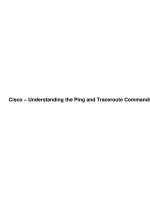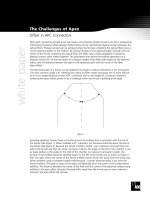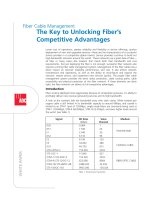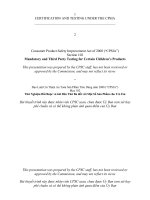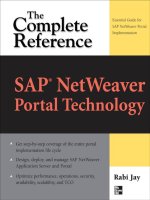Tài liệu Pro Bash Programming: Scripting the GNU/Linux Shell doc
Bạn đang xem bản rút gọn của tài liệu. Xem và tải ngay bản đầy đủ của tài liệu tại đây (5.77 MB, 257 trang )
Pro
Johnson
Bash Programming
Companion
eBook
Available
Covering
Bash 4.0
this print for content only—size & color not accurate
Books for professionals By professionals
®
Cyan
MaGenTa
yelloW
BlaCk
US $34.99
Shelve in
Linux
User level:
Beginner–Intermediate
Intermediate–Advanced
Advanced
www.apress.com
SOURCE CODE ONLINE
Companion eBook
See last page for details
on $10 eBook version
ISBN 978-1-4302-1997-2
9 781430 219972
5 34 9 9
Pro Bash Programming:
Scripting the GNU/Linux Shell
Dear Reader,
The shell is a programming language! A shell script is as much a program as
anything written in C, Python, or any other programming language. Just
because shell scripts are easier to write doesn’t mean they should take a back-
seat to compiled programs or other scripting languages.
I wrote Pro Bash Programming to present a tutorial that introduces the shell,
and bash specifically, as a programming language. If you need a program to
accomplish a task on GNU/Linux or any other Unix-type system, I want you
to consider the shell before any other language. If you write a prototype for a
program using the shell, I want you to realize that you don’t need to translate it
to another language.
This book will give you a grounding in programming techniques used in
writing shell programs no matter what your past programming experience. If
you’ve never written a computer program before, Pro Bash Programming will
get you started and help you become a proficient shell programmer. If you
have written a few shell programs, this book will take you to the next level and
beyond. It will enable you to do things with the shell you never thought it could
do. If you are already an expert shell programmer, this book will provide insight
into the advanced shell programming, helping you write more, and more effi-
cient, scripts.
Bash is the shell of the Free Software Foundation’s GNU project and is the
standard shell on almost all Linux distributions. It is the shell you probably
use at the command line. It offers programmers many enhancements over the
standard Unix shell. You will find bash on many versions of Unix. It may not be
the default shell, but it is usually available for interpreting your scripts.
I hope this book will help you become a more productive programmer and
that your programs will be written using the Bash shell.
Chris F.A. Johnson
Author of
Shell Scripting Recipes:
A Problem-Solution
Approach
THE APRESS ROADMAP
Beginning the
Linux Command Line
Linux System
Administration Recipes
Beginning Portable Shell Scripting
Expert Shell
Scripting
Pro Bash
Programming
Beginning Perl 2nd Edition
Beginning Ubuntu LTS Server
Administration 2nd Edition
trim = 7.5" x 9.25" spine = 0.5625" 256 page count
The eXperT’s VoiCe
®
in linuX
Pro
Bash
Programming
Scripting the GNU/Linux Shell
Chris F.A. Johnson
Programming bash from one-liners
to professional programs
Covering
Bash 4.0
www.it-ebooks.info
■ CONTENTS
i
Pro Bash Programming
Scripting the GNU/Linux Shell
■ ■ ■
Chris F.A. Johnson
www.it-ebooks.info
■ CONENTS
ii
Pro Bash Programming: Scripting the GNU/Linux Shell
Copyright © 2009 by Chris F.A. Johnson
All rights reserved. No part of this work may be reproduced or transmitted in any form or by any means,
electronic or mechanical, including photocopying, recording, or by any information storage or retrieval
system, without the prior written permission of the copyright owner and the publisher.
ISBN-13 (pbk): 978-1-4302-1997-2
ISBN-13 (electronic): 978-1-4302-1998-9
Printed and bound in the United States of America 9 8 7 6 5 4 3 2 1
Trademarked names may appear in this book. Rather than use a trademark symbol with every
occurrence of a trademarked name, we use the names only in an editorial fashion and to the benefit of
the trademark owner, with no intention of infringement of the trademark.
Lead Editor: Frank Pohlmann
Technical Reviewer: Ed Schaefer
Editorial Board: Clay Andres, Steve Anglin, Mark Beckner, Ewan Buckingham, Tony Campbell,
Gary Cornell, Jonathan Gennick, Jonathan Hassell, Michelle Lowman, Matthew Moodie,
Jeffrey Pepper, Frank Pohlmann, Douglas Pundick, Ben Renow-Clarke, Dominic Shakeshaft,
Matt Wade, Tom Welsh
Project Manager: Kylie Johnston
Copy Editor: Kim Wimpsett
Compositor: ContentWorks, Inc.
Indexer: Julie Grady
Distributed to the book trade worldwide by Springer-Verlag New York, Inc., 233 Spring Street, 6th Floor,
New York, NY 10013. Phone 1-800-SPRINGER, fax 201-348-4505, e-mail , or
visit .
For information on translations, please contact Apress directly at 233 Spring Street, New York, NY 10013.
E-mail , or visit .
Apress and friends of ED books may be purchased in bulk for academic, corporate, or promotional use.
eBook versions and licenses are also available for most titles. For more information, reference our
Special Bulk Sales–eBook Licensing web page at
The information in this book is distributed on an “as is” basis, without warranty. Although every
precaution has been taken in the preparation of this work, neither the author(s) nor Apress shall have
any liability to any person or entity with respect to any loss or damage caused or alleged to be caused
directly or indirectly by the information contained in this work.
The source code for this book is available to readers at
.
www.it-ebooks.info
■ CONTENTS
iii
Contents at a Glance
■About the Author xvi
■About the Technical Reviewer xvii
■Introduction xix
■Chapter 1: Hello, World! Your First Shell Program 1
■Chapter 2: Input, Output, and Throughput 7
■Chapter 3: Looping and Branching 19
■Chapter 4: Command-Line Parsing and Expansion 29
■Chapter 5: Parameters and Variables 43
■Chapter 6: Shell Functions 59
■Chapter 7: String Manipulation 67
■Chapter 8: File Operations and Commands 79
■Chapter 9: Reserved Words and Builtin Commands 97
■Chapter 10: Writing Bug-Free Scripts and Debugging the Rest 113
■Chapter 11: Programming for the Command Line 125
■Chapter 12: Runtime Configuration 141
■Chapter 13: Data Processing 157
■Chapter 14: Scripting the Screen 179
■Chapter 15: Entry-Level Programming 191
■Appendix: Shell Variables 205
■Index 221
www.it-ebooks.info
www.it-ebooks.info
■ CONTENTS
v
Contents
■About the Author xvi
■About the Technical Reviewer xvii
■Introduction xix
■Chapter 1: Hello, World! Your First Shell Program 1
The Code 1
The File 2
The Naming of Scripts 2
Selecting a Directory for the Script 2
Creating the File and Running the Script 3
Choosing and Using a Text Editor 3
Building a Better “Hello, World!” 5
Summary 5
Commands 5
Concepts 6
Variables 6
Exercises 6
■Chapter 2: Input, Output, and Throughput 7
Parameter and Variables 7
Positional Parameters 7
Special *@#0$?_!- Parameters 8
Variables 8
Arguments and Options 8
echo, and Why You Should Avoid It 9
printf: Formatting and Printing Data 9
Escape Sequences 10
Format Specifiers 10
www.it-ebooks.info
■ CONENTS
vi
Width Specification 11
Printing to a Variable 13
Line Continuation 13
Standard Input/Output Streams and Redirection 13
Redirection: >, >>, and < 13
Reading Input 15
Pipelines 15
Command Substitution 16
Summary 16
Commands 16
Concepts 16
Exercises 17
■Chapter 3: Looping and Branching 19
Exit Status 19
Testing an Expression 19
test, aka [ ] 20
[[ ]]: Evaluate an Expression 21
(( )): Evaluate an Arithmetic Expression 22
Lists 22
Conditional execution 22
if 22
Conditional Operators, && and || 23
case 24
Looping 25
while 25
until 26
for 26
break 26
continue 27
Summary 27
Commands 27
Concepts 28
Exercises 28
www.it-ebooks.info
■ CONTENTS
vii
■Chapter 4: Command-Line Parsing and Expansion 29
Quoting 30
Brace Expansion 31
Tilde Expansion 32
Parameter and Variable Expansion 33
Arithmetic Expansion 33
Command Substitution 35
Word Splitting 36
Pathname Expansion 37
Process Substitution 37
Parsing Options 38
Summary 41
Commands 41
Exercises 41
■Chapter 5: Parameters and Variables 43
The Scope of a Variable: Can You See It from Here? 43
Shell Variables 44
The Naming of Variables 46
Parameter Expansion 46
Bourne Shell 46
POSIX Shell 49
Bash 51
Bash-4.0 52
Positional Parameters 53
Arrays 54
Integer-Indexed Arrays 54
Associative Arrays 56
Summary 56
Commands 56
Concepts 57
Exercises 57
■Chapter 6: Shell Functions 59
Definition Syntax 59
www.it-ebooks.info
■ CONENTS
viii
Compound Commands 61
Getting Results 62
Set Different Exit Codes 62
Print the Result 63
Place Results in One or More Variables 63
Function Libraries 64
Using Functions from Libraries 64
Sample Script 64
Summary 66
Commands 66
Exercises 66
■Chapter 7: String Manipulation 67
Concatenation 67
Repeat Character to a Given Length 68
Processing Character by Character 69
Reversal 70
Case Conversion 70
Comparing Contents Without Regard to Case 72
Check for Valid Variable Name 73
Insert One String into Another 74
Examples 74
Overlay 74
Examples 75
Trim Unwanted Characters 75
Examples 76
Index 77
Summary 78
Commands 78
Functions 78
Exercises 78
www.it-ebooks.info
■ CONTENTS
ix
■Chapter 8: File Operations and Commands 79
Reading a File 79
External Commands 81
cat 81
head 82
touch 83
ls 83
cut 84
wc 85
Regular Expressions 85
grep 86
sed 87
awk 88
File Name Expansion Options 89
nullglob 90
failglob 91
dotglob 91
extglob 91
nocaseglob 93
globstar 93
Summary 94
Shell Options 94
External Commands 94
Exercises 95
■Chapter 9: Reserved Words and Builtin Commands 97
help, Display Information About Builtin Commands 97
time, Print Time Taken for Execution of a Command 98
read, Read a Line from an Input Stream 99
-r, Read Backslashes Literally 99
-e, Get Input with the readline Library 100
-a, Read Words into an Array 100
-d DELIM, Read Until DELIM Instead of a Newline 101
-n NUM, Read a Maximum of NUM Characters 101
-s, Do Not Echo Input Coming from a Terminal 101
www.it-ebooks.info
■ CONENTS
x
-p PROMPT:, Output PROMPT Without a Trailing Newline 101
-t TIMEOUT, Only Wait TIMEOUT Seconds for Complete Input 102
-u FD: Read from File Descriptor FD Instead of the Standard Input 102
-i TEXT, Use TEXT as the Initial Text for readline 103
eval, Expand Arguments and Execute Resulting Command 103
Poor Man’s Arrays 104
Setting Multiple Variables from One Command 106
type, Display Information About Commands 106
builtin, Execute a Builtin Command 108
command, Execute a Command or Display Information About Commands 108
pwd, Print the Current Working Directory 108
unalias, Remove One or More Aliases 109
Deprecated Builtins 109
Dynamically Loadable Builtins 109
Summary 110
Commands and Reserved Words 110
Deprecated Commands 111
Exercises 111
■Chapter 10: Writing Bug-Free Scripts and Debugging the Rest 113
Prevention Is Better Than Cure 113
Structure Your Programs 113
Document Your Code 116
Format Your Code Consistently 117
The K.I.S.S. Principle 117
Test As You Go 118
Debugging a Script 120
Summary 123
Exercises 123
■Chapter 11: Programming for the Command Line 125
Manipulating the Directory Stack 125
cd 125
pd 126
cdm 127
menu 128
www.it-ebooks.info
■ CONTENTS
xi
Filesystem Functions 129
l 129
lsr 130
cp, mv 131
md 131
Miscellaneous Functions 132
pr1 132
calc 133
Managing Man Pages 133
sman 133
sus 134
k 134
Games 134
The Fifteen Puzzle 136
Summary 140
Exercises 140
■Chapter 12: Runtime Configuration 141
Defining Variables 141
Command-Line Options and Arguments 141
Menus 142
Q&A Dialogue 143
Configuration Files 143
Scripts with Several Names 144
Environment Variables 146
All Together Now 146
## Script Information 147
## Default Configuration 147
## Screen Variables 148
## Function Definitions 148
## Parse Command-Line Options 154
## Bits and Pieces 155
Summary 156
Exercises 156
www.it-ebooks.info
■ CONENTS
xii
■Chapter 13: Data Processing 157
Arrays 157
Holes in an Indexed Array 157
Using an Array for Sorting 158
Two-Dimensional Grids 163
Data File Formats 171
Line-Based Records 172
Block File Formats 175
Summary 176
Exercises 177
■Chapter 14: Scripting the Screen 179
Teletypewriter vs. Canvas 179
Stretching the Canvas 180
CSI: Command Sequence Introducer 180
Priming the Canvas 181
Moving the Cursor 181
Changing Rendition Modes and Colors 182
Placing a Block of Text on the Screen 183
Scrolling Text 186
Rolling Dice 187
Summary 189
Exercises 189
■Chapter 15: Entry-Level Programming 191
Single-Key Entry 191
Function Library, key-funcs 191
History in Scripts 197
Sanity Checking 198
Form Entry 199
Reading the Mouse 200
Summary 204
Exercises 204
www.it-ebooks.info
■ CONTENTS
xiii
■Appendix: Shell Variables 205
BASH 205
BASHPID 205
BASH_ALIASES 205
BASH_ARGC 205
BASH_ARGV 205
BASH_CMDS 206
BASH_COMMAND 206
BASH_EXECUTION_STRING 206
BASH_LINENO 206
BASH_REMATCH 206
BASH_SOURCE 206
BASH_SUBSHELL 206
BASH_VERSINFO 207
BASH_VERSION 207
COMP_CWORD 207
COMP_KEY 207
COMP_LINE 207
COMP_POINT 207
COMP_TYPE 208
COMP_WORDBREAKS 208
COMP_WORDS 208
DIRSTACK 208
EUID 208
FUNCNAME 208
GROUPS 209
HISTCMD 209
HOSTNAME 209
HOSTTYPE 209
LINENO 209
MACHTYPE 209
OLDPWD 209
OPTARG 209
OPTIND 210
OSTYPE 210
PIPESTATUS 210
www.it-ebooks.info
■ CONENTS
xiv
PPID 210
PWD 210
RANDOM 210
REPLY 210
SECONDS 210
SHELLOPTS 211
SHLVL 211
UID 211
BASH_ENV 211
CDPATH 211
COLUMNS 211
COMPREPLY 211
EMACS 212
FCEDIT 212
FIGNORE 212
GLOBIGNORE 212
HISTCONTROL 212
HISTFILE 212
HISTFILESIZE 213
HISTIGNORE 213
HISTSIZE 213
HISTTIMEFORMAT 213
HOME 213
HOSTFILE 213
IFS 214
IGNOREEOF 214
INPUTRC 214
LANG 214
LC_ALL 214
LC_COLLATE 214
LC_CTYPE 214
LC_MESSAGES 214
LC_NUMERIC 215
LINES 215
MAIL 215
MAILCHECK 215
MAILPATH 215
www.it-ebooks.info
■ CONTENTS
xv
OPTERR 215
PATH 215
POSIXLY_CORRECT 216
PROMPT_COMMAND 216
PROMPT_DIRTRIM 216
PS1 216
PS2 216
PS3 216
PS4 216
SHELL 217
TIMEFORMAT 217
TMOUT 217
TMPDIR 217
auto_resume 217
histchars 218
■Index 221
www.it-ebooks.info
■ CONENTS
xvi
About the Author
■After almost 20 years in magazine and newspaper publishing, variously as writer,
editor, graphic designer, and production manager, Chris F.A. Johnson now earns
his living composing cryptic crossword puzzles, teaching chess, designing and
coding web sites, and programming and writing books about shell scripting. His
first book, Shell Scripting Recipes: A Problem-Solution Approach, was published by
Apress in 2005.
Introduced to Unix in 1990, Chris learned shell scripting because there was no
C compiler on the system. His first major project was a menu-driven, user-
extensible database system with a report generator. Constantly writing scripts for
any and all purposes, his recent shell projects have included utilities for
manipulating crossword puzzles and preparing chess resources for his students.
www.it-ebooks.info
■ CONTENTS
xvii
About the Technical Reviewer
■Ed Schaefer is an ex-paratrooper, an ex-military intelligence officer, an ex-oil
field service engineer, and a past contributing editor and columnist for Sys Admin.
He’s not a total has-been. He earned a BSEE from South Dakota School of Mines
and an MBA from USD.
Currently, he fixes microstrategy and teradata problems–with an occasional
foray into Linux–for a Fortune 50 company.
www.it-ebooks.info
www.it-ebooks.info
■ INTRODUCTION
xix
Introduction
Although most users think of the shell as an interactive command interpreter, it is really a
programming language in which each statement runs a command. Because it must satisfy
both the interactive and programming aspects of command execution, it is a strange
language, shaped as much by history as by design.
Brian Kernighan and Rob Pike, The UNIX Programming Environment, Prentice-Hall, 1984
The shell is a programming language. Don’t let anyone tell you otherwise. The shell is not just glue that
sticks bits together. The shell is a lot more than a tool that runs other tools. The shell is a complete
programming language!
When a Linux user asked me about membership databases, I asked him what he really needed. He
wanted to store names and addresses for a couple of hundred members and print mailing labels for each
of them. I recommended using a text editor to store the information in a text file, and I provided a shell
script to create the labels in PostScript. (The script, ps-labels, appeared in my first book, Shell Scripting
Recipes: A Problem-Solution Approach.)
When the SWEN worm was dumping hundreds of megabytes of junk into my mailbox every few
minutes, I wrote a shell script to filter them out on the mail server and download the remaining mail to
my home computer. That script has been doing its job for several years.
I used to tell people that I did most of my programming in the shell but switched to C for anything
that needed the extra speed. It has been several years since I have needed to use C, so I no longer
mention it. I do everything in the shell.
A shell script is as much a program as anything written in C, Python, or any other language. Just
because shell scripts are easier to write doesn’t mean they should take a backseat to compiled programs
or other scripting languages. I use the terms script and program interchangeably when referring to tasks
written in the shell.
Why the Shell?
Some Linux users do all of their work in a GUI environment and never see a command line. Most,
however, use the shell at least occasionally and know something about Unix commands. It’s not a big
step from there to saving oft-repeated commands in a script file. When they need to extend the
capabilities of their system, the shell is the natural way to go.
The shell also has important advantages over other programming languages:
• It interfaces simply and seamlessly with the hundreds of Unix utilities.
• It automatically expands wildcards into a list of file names.
• Lists contained in a variable are automatically split into their constituent parts.
www.it-ebooks.info
■ INTRODUCTION
xx
Just the Shell, Ma’am, Just the Shell
While most shell programs do call external utilities, a lot of programming can be done entirely in the
shell. Many scripts call just one or two utilities for information that is used later in the script. Some
scripts are little more than wrappers for other commands such as awk, grep, or sed.
This book is about programming in the shell itself. There’s a sprinkling of the second type, where
the script gets information (such as the current date and time) and then processes it. The third type gets
barely more than a cursory nod.
A Brief History of sh
The Bourne shell was the first Unix shell in general use. It was much more limited than today’s shells, so
it was primarily a tool to run other tools. It had variables, loops, and conditional execution, but the real
work was done almost entirely by external utilities.
The C shell, csh, added command history, arithmetic, and other features that made it popular as a
command-line interpreter, but it was not suitable for more than trivial scripts.
The KornShell, developed by David Korn at AT&T Bell Labs, combined the Bourne shell syntax with
features of the C shell. It was compatible with the Bourne shell, bringing important functionality into the
shell itself and making script execution much faster. Until the year 2000, when it was opened up, ksh was
proprietary, closed-source software.
The GNU Project, needing a free, open-source shell, introduced bash. Like all modern shells, bash is
a POSIX shell. It also has many added enhancements.
Which Version of Bash?
This book is aimed at users of bash-3 and later, but much of the book will work with bash-2.05. Features
introduced in bash-4.0, are covered, but it is noted that they are newer additions. Wherever possible
without loss of efficiency, the scripts in this book are written to run in any POSIX shell. It is often noted
when a statement in a script is nonstandard or uses bash syntax. That means that it is not POSIX
compliant. Most functions, however, will not run in a POSIX shell because they almost always use the
local builtin command.
Some Linux distributions modify their versions of bash: Debian removes network socket
capabilities. Mandriva removes the builtin time command. For this reason, I recommend compiling your
own copy of bash. The source code is available from
and it compiles without trouble almost
anywhere.
Who Will Benefit from This Book?
If you’re an experienced shell programmer, this book will provide insight into the arcana of shell
scripting, helping you write more, and more efficient, scripts.
If you have dabbled in shell scripting, I hope this book will encourage you to experiment further.
If you are new to shell scripting, this book will get you started and help you quickly become a
proficient shell programmer.
No matter what your level of experience, this book will enable you to program tasks that aren’t
already dealt with on your system.
www.it-ebooks.info
■ INTRODUCTION
xxi
What’s in the Book?
From writing your first program to using the mouse in your scripts, this book runs the gamut from
simple to complex and from the obvious to the obscure. It covers every technique you will need to write
efficient shell programs.
Chapter 1, Hello, World! Your First Shell Program, presents the traditional first program in any
language. It prints “Hello, World!” The chapter discusses how to write the script, what to name it,
and where to put it.
Chapter 2, Input, Output, and Throughput, demonstrates output using the echo and printf
commands and introduces the read command for input. It also examines redirecting both input
and output and connecting commands with pipelines.
Chapter 3, Looping and Branching, explains the looping statements, for, while, and until; the
branching statement if; and the conditional operators && and ||.
Chapter 4, Command-Line Parsing and Expansion, describes how the shell parses a command
line, from word splitting to parameter expansion.
Chapter 5, Variables and Parameters, covers all the possibilities of parameters and variables,
from scalar variables to associative arrays and from default substitution to search and replace.
Chapter 6, Shell Functions, delves into the syntax of function definitions and defines a number
of useful routines.
Chapter 7, String Manipulation, contains a number of functions for dicing and splicing strings.
Chapter 8, File Operations and Commands, uses more external commands than the rest of the
book put together. That’s because looping through a large file with the shell is painfully slow, and
the Unix utilities are very efficient. This chapter also tells you when not to use those utilities.
Chapter 9, Reserved Words and Builtin Commands, looks at a number of commands that are
built into the shell itself.
Chapter 10, Writing Bug-Free Scripts and Debugging the Rest, takes a buggy script and takes
you step-by-step through fixing it, as well as showing you how to prevent bugs in the first place.
Chapter 11, Programming for the Command Line, is for those people who spend a lot of time at
the command prompt. These programs and functions reduce the typing to a minimum.
Chapter 12, Runtime configuration, describes seven methods of altering a program’s runtime
behavior.
Chapter 13, Data Processing, deals with manipulating different types of data in the shell.
Chapter 14, Scripting the Screen, shows you how to write to the screen as if it were a canvas
rather than a teletypewriter.
Chapter 15, Entry-Level Programming, presents techniques for getting input from a user, both
using single keypresses and entering and editing a line of text. It concludes with routines for
using the mouse in shell scripts.
The appendix lists all the variables used by bash with a description of each.
www.it-ebooks.info
■ INTRODUCTION
xxii
Downloading the Code
The source code for this book is available to readers as a gzipped tarball file at www.apress.com in the
Downloads section of this book’s home page. Please feel free to visit the Apress web site and download
all the code there. You can also check for errata and find related titles from Apress.
Contacting the Author
The author maintains a web site at and can be reached via e-mail at
www.it-ebooks.info
C H A P T E R 1
1
Hello, World!
Your First Shell Program
A shell script is a file containing one or more commands that you would type on the command line. This
chapter describes how to create such a file and make it executable. It also covers some other issues
surrounding shell scripts, including what to name the files, where to put them, and how to run them.
I will begin with the first program traditionally demonstrated in every computer language: a
program that prints “Hello, World!” in your terminal. It’s a simple program, but it is enough to
demonstrate a number of important concepts. The code itself is the simplest part of this chapter.
Naming the file and deciding where to put it are not complicated tasks, but they are important.
For most of this chapter, you will be working in a terminal. it could be a virtual terminal, a terminal
window, or even a dumb terminal. In your terminal, the shell will immediately execute any commands
you type (after you press Enter, of course).
You should be in your home directory, which you can find in the variable $HOME:
echo $HOME
You can find the current directory with either the pwd command or the PWD variable:
pwd
echo "$PWD"
If you are not in your home directory, you can get there by typing cd and pressing Enter at the shell
prompt.
The Code
The code is nothing more than this:
echo Hello, World!
There are three words on this command line: the command itself and two arguments. The
command, echo, prints its arguments separated by a single space and terminated with a newline.
www.it-ebooks.info
CHAPTER 1 HELLO, WORLD! YOUR FIRST SHELL PROGRAM
2
The File
Before you turn that code into a script, you need to make two decisions: what you will call the file and
where you will put it. The name should be unique (that is, it should not conflict with any other
commands), and you should put it where the shell can find it.
The Naming of Scripts
Beginners often make the mistake of calling a trial script test. To see why that is bad, enter the following
at the command prompt:
type test
The type command tells you what the shell will execute (and where it can be found if it is an
external file) for any given command. In bash, type -a test will display all the commands that match
the name test:
$ type test
test is a shell builtin
$ type -a test
test is a shell builtin
test is /usr/bin/test
As you can see, a command called test already exists; it is used to test file types and to compare
values. If you call your script test, it will not be run when you type test at the shell prompt; the first
command identified by type will be run instead. (I’ll talk more about both type and test in later
chapters.)
Typically, Unix command names are as short as possible. They are often the first two consonants of
a descriptive word (for example, mv for move or ls for list) or the first letters of a descriptive phrase (for
example , ps for process status or sed for stream editor).
For this exercise, call the script hw. Many shell programmers add a suffix, such as .sh, to indicate that
the program is a shell script. The script doesn’t need it, and I use one only for programs that are being
developed. My suffix is -sh, and when the program is finished, I remove it. A shell script becomes
another command and doesn’t need to be distinguished from any other type of command.
Selecting a Directory for the Script
When the shell is given the name of a command to execute, it looks for that name in the directories listed
in the PATH variable. This variable contains a colon-separated list of directories that contain executable
commands. This is a typical value for $PATH:
/bin:/usr/bin:/usr/local/bin:/usr/games
If your program is not in one of the PATH directories, you must give a pathname, either absolute or
relative, for bash to find it. An absolute pathname gives the location from the root of the filesystem, such
as /home/chris/bin/hw; a relative pathname is given in relation to the current working directory (which
should currently be your home directory), as in bin/hw.
www.it-ebooks.info
